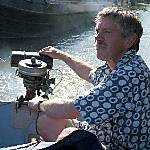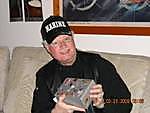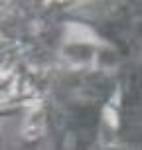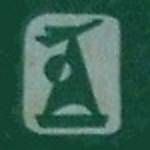You are viewing the archived version of the site.
Go to modelshipwrights.com for the current dynamic site!
Go to modelshipwrights.com for the current dynamic site!
1⁄350USS Lexington (CV2) 1927-1942
23
Comments
Stage 31: rigging and stores handling (part 1)
Scratch parts: 22
Time: 2.75 hours
The outrigging structure at the rear of the forward 5-inch control top was made from stretched sprue.
Aerial spreaders at the top of the stack (fore and aft) were made from brass wire. The battle gaff (represented by kit part D10) is very thin, being little thicker than a halyard and almost invisible in photographs. The kit part was discarded and replaced with stretched sprue.
Flag staffs at bow and stern were made from brass wire. The steering pole on the starboard side forward of the aircraft handling crane was made from stretched sprue. This could be stowed flat on the deck but I decided to model it in the mounted position for added visual interest. It actually occupies the hole in the flight deck (slightly too far aft) intended for the starboard paravane derrick.
The kingposts for the portable stores-handling derricks (I chose two on the port side – replacing kit parts F11 - and one abaft the rear aircraft elevator) were made from styrene rod with a single wrapping of masking tape top and bottom to increase the diameter at these points. The associated booms were made in a similar way, with two separate layers of masking tape used to increase the diameter in the mid-sections.
On the Lexington pulley blocks were attached to the flight deck to run hoists from the derricks back to their associated winches. On the model these were made from thin brass wire inserted almost flush into holes drilled in the flight deck.

Above: Scratch-built portable kingpost and derrick after rigging.
Stage 32: paint finishing
Time: 2.5 hours
The overall flat finish of the matt paint made the ship look like it had been marooned aground in a very arid desert for months. It also looked rather ‘rubbery’ and soft, with little impression of hard painted steel afloat in a wet environment.
I decided to lift the finish and improve the reflective qualities - particularly on the weapons, which looked totally un-metallic and unrealistic in a flat finish. Satin varnish seemed ideal, but had absolutely no effect whatsoever on the rather gritty, and very absorbent, airbrushed finish. On the other hand, where I had brush-painted, it was too effective.
I switched to thinned-out gloss varnish which created the desired effect, depending on the thickness sprayed on. This sounds frightening and undesirable, as though it would create a highly reflective and rather plastic finish, but it didn’t at all. I was quite selective where I applied it – plenty on the weapons and along the waterline, a moderate amount on the very dry looking flight deck, and very sparingly on the hull and upper works vertical surfaces.
The varnish improved the colour depth of the paint (which had previously looked rather chalky) and helped protect the paint finish which had been very prone to scuffing and marking.
Stage 33: rigging and stores handling (part 2)
Scratch parts: 64
Time: 12 hours
All rigging was done in 0.1mm (2ib 5oz/1.07kg) monofilament fishing line. I left all wireless aerials and the rigging for the foremast in natural finish. Elsewhere, I found rope work for the derricks, whaler davits and boat booms to be almost invisible against the background colour. To make these more visible I experimented with different shades of grey paint, with a bias towards brown/greys rather than the blue/greys of the ship. Standard Navy Grey was too light and Standard Navy Deck Grey was too dark and too blue. I settled on an old tin of Humbrol USN 2, 36270, but I don’t know if this is still available. However, a word of warning: solvent-based paint seems to have a tendency to loosen the tension in the rigging. For the cross-deck rope work for the derricks I ran a black spirit-based marker along the line before cutting and fixing it.
The finishing touch was the bearing light carried high up on the inboard side of the stack. This was made up from brass wire and stretched sprue.

Above: Rigging around the bridge area.
Stage 34: side ladders
PE parts: 12
Scratch parts: 18
Time: 2.25 hours
In British terminology these are called accommodation ladders. In the Lexington they provided access between the hull-side accommodation ports and boats alongside. I made up the ladders from spare PE and the upper and lower platforms from styrene sheet. The lower platform supporting structures with their cross-braces were cut from the WEM ‘ultimate destroyer’ set. The structures were assembled using temporary water-level platforms made from sheet styrene glued to the underside of the hull edges. When everything was in place and set solid these platforms were cut away.

Above: Aft side ladder on temporary assembly platform.
Comments
Hi Joseph,
Yeah, it was a lot of research. I was DETERMINED to make it abolutely as accurate as possible. What I don't understand is how Trumpeter got so much of it grotesquely wrong. Anyway, thanks for your comments. I sure hope you find my feature useful - from what I've seen the 1:700 from Trumpeter is just a scaled down version of the 1:350 kit, including everything that's wrong with the big one!
JUL 08, 2008 - 05:36 AM
Hi Rui
Well, well, well. I used to be a graphic designer myself as well. And a copywriter. Hence what I hope is a deal of professionalism in my SBS guide.
The whole project spanned two years. I didn't dare start another model in all that time, knowing it would simply delay completion and possibly I would lose my motivation. Sometimes it was very hard to keep going - the progress when doing the armament and the air group seemed so slow. I really had to force myself to keep going.
Thanks for the advice on using Clearcoat on the decals. Actually, that is what I did use, in order to soften the decals so they would lay close on the curved fuselage sides, to get them to stick, and to try and dull them down. All the planes were matt varnished as well, but that still didn't kill the decal edge reflection.
You can see some of my 1:700 stuff at: LINK If you select my name from the top of the menu on the left you can see all my galleries.
By the way, the 1:700 Trumpeter Lexington looks like just a scaled-down version of the 1:350 version, including everything that is wrong and inaccurate. So please, please, do use all the research I did to get it right. I look forward to seeing the result!
Regards, Chris
JUL 08, 2008 - 05:48 AM
Jim
Your comments an honour indeed. I have followed your work over the years at Modelwarships.com and you really are the best. Counting the hours is actually a way of giving myelf a sanity check! Which is why to some extent the whole project took me two years from start to finish.
Regards, Chris
JUL 08, 2008 - 05:53 AM
Thanks for taking time to answer to my questions!
I have the 1/700 Trumpeter model, for Coral Sea fit, so I guess you have done all the research for me - but still, I have to get the work myself!
Not for now, but for a "near" future (I am currently working on three projects, one a full scratch all in 1/700).
Thanks for the link, and since my memory is better for graphics, than for names, I can say that I had already seen your Sara / Lex duo in MW.
Please keep up - keep your ship models afloat!
Rui
JUL 08, 2008 - 05:57 AM
Are you sure that thing is a model. It looks so real. In some of those photos it looks too real. Nice job. Amazinglly nice job. Great tribute to those who sailed, fought and died on board the original Lady Lex carrier. Nice work.
JUL 11, 2008 - 08:46 AM
Hi Chris,
Sorry no plans on any new 1/350 items.
You could use my YC-728 or 829 for an open ammunition lighter. I have some photos of their use as such.
JUL 15, 2008 - 07:06 AM
Hello Chris:
I just finished reading your build log. Outstanding work and very well written. I have this kit, not sure I want to tackle all the inaccuracies vice just building an OOB kit, but, your work is inspirational and you presented a lot of neat ideas to enhance the kit. I will be referencing your build log when I tackle mine. Thanks for posting and sharing.
FEB 10, 2015 - 08:49 AM
Mark, I doubt Chris will respond as this is a 7 year old tread and Chris last signed in 7 years ago.
FEB 10, 2015 - 09:13 AM
wow, awesome model building.
well worth resurrecting the thread and feature.
FEB 11, 2015 - 09:17 AM
Copyright ©2021 by Chris Smithers. _OPINIONS Model Shipwrights, KitMaker Network, or Silver Star Enterrpises. Images also by copyright holder unless otherwise noted. Opinions expressed are those of the author(s) and not necessarily those of Model Shipwrights. All rights reserved. Originally published on: 2008-07-04 00:00:00. Unique Reads: 23646














